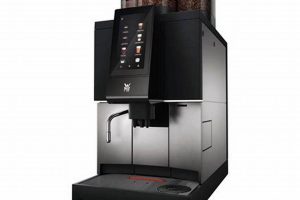The selection of optimal equipment for crafting traditional Cuban coffee hinges on the machine’s ability to generate high pressure and consistent temperature. These factors are critical for extracting the robust flavors and creating the characteristic crema associated with this intensely flavored beverage. A machine’s suitability is determined by its capacity to handle finely ground coffee and its capacity to produce a concentrated shot.
Choosing the appropriate device ensures a flavorful and authentic experience. Historically, stovetop espresso makers (Moka pots) were the standard. While still viable, modern espresso machines offer greater control and consistency, leading to a more predictable and refined final product. The benefit lies in the machine’s capability to precisely manage variables like water temperature and pressure, minimizing the risk of bitterness or under-extraction.
Therefore, the following sections will delve into the specific features and models that contribute to superior brewing, exploring both manual and automatic options and providing a practical guide for selecting the ideal appliance.
Brewing Excellence
Achieving authentic results requires careful attention to several key aspects related to the equipment.
Tip 1: Pressure Consistency: Maintain a steady pressure of at least 9 bars. This is crucial for proper extraction and the formation of the characteristic crema.
Tip 2: Temperature Stability: The machine should offer stable temperature control. An ideal range of 195-205F (90-96C) ensures optimal flavor extraction without burning the coffee.
Tip 3: Pre-infusion Capability: A pre-infusion feature allows the coffee grounds to bloom, leading to a more even extraction and enhanced flavor complexity.
Tip 4: Portafilter Quality: Use a heavy, well-built portafilter. This helps maintain temperature stability during the brewing process.
Tip 5: Grinder Compatibility: Ensure the coffee grinder is capable of producing an extremely fine grind, essential for achieving the desired intensity.
Tip 6: Machine Maintenance: Regular cleaning and descaling are essential for maintaining optimal performance and extending the machine’s lifespan.
Proper equipment is not solely about the cost but rather the machine’s ability to consistently produce high-quality results. Selecting a machine with these features contributes to a superior coffee experience.
The subsequent sections will discuss specific models that exemplify these characteristics.
1. Pressure Stability
Pressure stability is a paramount factor in the selection of espresso machines intended for the preparation of authentic Cuban coffee. Inadequate pressure control can significantly compromise the extraction process, resulting in a suboptimal beverage.
- Crema Formation
Consistent pressure, typically around 9 bars, is essential for emulsifying the coffee oils and producing the characteristic crema the dense, reddish-brown foam that defines a well-extracted espresso. Insufficient or fluctuating pressure leads to a thin, weak crema or its absence, detracting from the overall sensory experience.
- Flavor Extraction
Stable pressure ensures uniform extraction of the desired flavor compounds from the finely ground coffee. Suboptimal pressure levels can lead to under-extraction, resulting in a sour or weak taste, or over-extraction, producing a bitter or burnt flavor. Consistent pressure prevents such inconsistencies, delivering a balanced and flavorful cup.
- Temperature Regulation Interdependence
Pressure stability is closely linked to temperature regulation within the machine. Fluctuations in pressure can cause corresponding variations in water temperature at the group head, further affecting the extraction process. Machines designed with robust pressure control mechanisms often incorporate temperature stability features, ensuring consistent brewing conditions.
- Pump Type and Design
The type of pump used in the espresso machine directly impacts its ability to maintain stable pressure. Vibratory pumps, common in entry-level machines, can exhibit pressure fluctuations, while rotary pumps, typically found in higher-end models, offer superior pressure stability. The design and construction of the pump, along with the machine’s overall hydraulic system, influence its pressure control capabilities.
Therefore, an espresso machine’s capability to maintain stable pressure is a decisive attribute when aiming to replicate the intense and flavorful profile of traditional Cuban coffee. Selecting a machine with a robust pressure control system ensures consistent extraction, optimal crema formation, and a balanced flavor profile, all crucial for an authentic result.
2. Temperature Control
Temperature control within an espresso machine is a fundamental determinant of its suitability for brewing authentic Cuban coffee. Fluctuations or inconsistencies in water temperature directly impact the extraction process, significantly altering the final beverage’s flavor profile.
- Flavor Profile Modulation
Precise temperature control allows for the targeted extraction of specific flavor compounds from the coffee grounds. Lower temperatures may result in under-extraction, leading to sour or weak flavors. Conversely, excessively high temperatures can cause over-extraction, producing bitter or burnt notes. A stable temperature within the optimal range (typically 195-205F or 90-96C) ensures a balanced extraction, highlighting the inherent sweetness and rich, dark chocolate notes characteristic of well-prepared Cuban coffee.
- Crema Development
Water temperature directly influences the viscosity and stability of the crema. Insufficient temperature can prevent proper emulsification of coffee oils, resulting in a thin or non-existent crema. Overheated water can denature the proteins responsible for crema formation, leading to a similar outcome. Precise temperature control promotes the formation of a dense, rich crema with a stable structure, enhancing the visual appeal and mouthfeel of the espresso.
- Machine Design and Stability
The espresso machine’s heating system design plays a crucial role in temperature stability. Thermoblock systems offer rapid heating but can be prone to temperature fluctuations. Boiler systems, especially those with PID (Proportional-Integral-Derivative) controllers, provide more consistent and stable temperature regulation. The machine’s insulation and thermal mass also contribute to its ability to maintain a consistent brewing temperature.
- Impact on Bean Variety
Different coffee bean varieties require slightly different brewing temperatures to achieve optimal flavor extraction. Cuban coffee beans, typically dark-roasted, benefit from consistent temperature to avoid exacerbating any potential bitterness. Precise control permits fine-tuning the brewing temperature to complement the specific bean characteristics, ensuring the most flavorful result.
In summary, the importance of temperature control cannot be overstated when selecting equipment for crafting high-quality Cuban coffee. A machine’s ability to maintain stable and precise water temperature directly impacts the flavor, crema, and overall quality of the resulting espresso, differentiating equipment that delivers an authentic result.
3. Grind Finess
Grind fineness constitutes a critical variable in the production of authentic Cuban coffee, interacting directly with the functionality and effectiveness of espresso machines. Appropriate grind size directly influences extraction efficiency, flavor profile, and the overall quality of the final product.
- Extraction Rate and Surface Area
Finer grinds provide a greater surface area for water to interact with, facilitating faster and more complete extraction of soluble compounds. In the context of Cuban coffee, typically a dark roast, a fine grind is crucial to effectively draw out the intense flavors and minimize under-extraction, which can lead to sour or weak notes.
- Crema Formation Influence
The fineness of the coffee grounds directly impacts the formation and stability of the crema. Insufficiently fine grinds result in reduced pressure and incomplete emulsification of coffee oils, leading to a thin or nonexistent crema. A properly fine grind allows for the creation of a rich, dense crema, a hallmark of well-prepared espresso.
- Machine Compatibility and Pressure Build-Up
Espresso machines designed for Cuban coffee preparation must be capable of handling and effectively utilizing finely ground coffee. Machines with inadequate pressure generation or flow control may struggle to properly extract from excessively fine grinds, leading to channeling or inconsistent results. Selecting a machine engineered to operate with fine grinds is paramount.
- Grinder Quality and Consistency
Achieving the required fineness and consistency necessitates a high-quality burr grinder. Blade grinders produce inconsistent particle sizes, resulting in uneven extraction. Burr grinders, especially those designed for espresso, provide a uniform grind, ensuring consistent extraction and minimizing the risk of undesirable flavors.
The interplay between grind fineness and machine capability is fundamental to achieving optimal results in Cuban coffee preparation. The selection of an espresso machine must be considered in tandem with the grinder’s capacity to produce a consistently fine grind, aligning with the machine’s pressure and extraction parameters to create a truly authentic and flavorful cup.
4. Portafilter Weight
Portafilter weight plays a crucial role in thermal stability during the espresso extraction process, a factor directly influencing the quality of Cuban coffee. A heavier portafilter, typically constructed of brass or other high-density metals, retains heat more effectively. This is significant because the portafilter preheated to brewing temperature, mitigates temperature fluctuations when cooler water is introduced during extraction. For Cuban coffee, where a robust and intense flavor profile is desired, maintaining consistent temperature is crucial for extracting the full spectrum of flavors without bitterness. A lighter portafilter is more prone to temperature loss, which can lead to inconsistent extraction and a less desirable final product. Example: A barista using a machine with a lightweight portafilter may observe inconsistent shot times and varying crema quality compared to using the same machine with a heavier portafilter.
The mass of the portafilter also impacts the distribution of heat across the coffee puck. A heavier portafilter provides more even heat distribution, reducing the risk of channeling a phenomenon where water bypasses portions of the coffee puck due to uneven resistance. Proper heat distribution ensures uniform extraction, leading to a more balanced and flavorful espresso. Consider a scenario where two espresso machines, identical except for the portafilter weight, are used to brew Cuban coffee. The machine with the heavier portafilter typically yields a smoother, more consistent espresso with fewer bitter notes, indicative of improved extraction uniformity. Some manufacturers intentionally design their portafilters with substantial weight to enhance thermal stability and improve extraction quality.
In conclusion, portafilter weight is not a negligible detail but a critical component in maintaining thermal stability and promoting even extraction, both vital for achieving the characteristic robust flavor of Cuban coffee. The choice of an espresso machine should consider the portafilter’s weight as a contributing factor to its overall performance and ability to consistently deliver high-quality results. A heavier portafilter translates to more stable temperature, even heat distribution, and improved extraction, ultimately leading to a superior cup of Cuban coffee.
5. Pre-infusion
Pre-infusion, a controlled wetting of the coffee grounds prior to full pressure extraction, significantly contributes to the quality of espresso, particularly when preparing Cuban coffee. This technique allows the coffee bed to saturate evenly, releasing trapped gases (blooming) and minimizing channeling during the subsequent extraction phase. In the context of Cuban coffee, where a strong and concentrated flavor is desired, pre-infusion aids in extracting a greater percentage of soluble solids, resulting in a more intense and nuanced cup. Without pre-infusion, the initial high-pressure water flow can create uneven pathways through the coffee, leading to under-extraction in some areas and over-extraction in others. For example, a machine lacking pre-infusion may produce a shot of Cuban coffee with a noticeable sourness alongside a bitter aftertaste, reflecting the uneven extraction.
The effectiveness of pre-infusion is contingent on the machine’s design and control mechanisms. Systems offering adjustable pre-infusion time and pressure allow for fine-tuning the process based on the specific coffee blend and desired flavor profile. A longer pre-infusion time may be beneficial for darkly roasted Cuban coffee, giving the grounds ample time to degas and absorb water, thereby promoting a more even extraction. Furthermore, the water temperature during pre-infusion also matters; too low a temperature can prolong the pre-infusion unnecessarily, while too high a temperature can initiate premature extraction. Some high-end machines incorporate programmable pre-infusion profiles, allowing users to optimize extraction parameters for different types of coffee. An example includes setting a gentle, low-pressure pre-infusion for 5 seconds followed by a short pause to promote water penetration throughout the puck.
In summary, pre-infusion is an integral feature for an espresso machine intended for Cuban coffee preparation. It promotes even saturation, reduces channeling, and enhances flavor extraction. While the implementation of pre-infusion can vary across different machines, the underlying principle remains the same: to prepare the coffee bed for optimal extraction. The efficacy of pre-infusion ultimately depends on the precision of the machine’s controls and the operator’s ability to adjust the pre-infusion parameters to suit the specific characteristics of the coffee being used, ultimately contributing to a more consistent and satisfying final product.
6. Machine Maintenance
The operational longevity and performance consistency of an espresso machine used for preparing Cuban coffee are intrinsically linked to rigorous maintenance protocols. The distinct characteristics of Cuban coffee, notably its fine grind and dark roast, necessitate heightened attention to equipment hygiene and upkeep. Neglecting maintenance leads to the accumulation of coffee oils and residue within the machine’s internal components, potentially compromising extraction quality and imparting undesirable flavors. For instance, a buildup of stale coffee grounds in the group head can cause channeling, leading to uneven extraction and a bitter, inconsistent espresso shot. Regular cleaning is not merely an aesthetic concern but a functional imperative for preserving the espresso machine’s operational effectiveness.
Scale buildup from mineral deposits in hard water represents another significant maintenance challenge. Scale accumulation within the boiler and heating elements reduces heating efficiency, causes temperature instability, and can ultimately lead to component failure. Descaling, performed at regular intervals, removes these mineral deposits, ensuring consistent temperature and pressure, both crucial for proper extraction. Furthermore, regular backflushing with appropriate cleaning detergents is essential for removing coffee oils from the group head and associated components. The frequency of descaling and backflushing depends on water hardness and usage frequency, necessitating adherence to manufacturer recommendations. A well-maintained machine delivers consistent extraction parameters, directly translating to a consistently high-quality cup of Cuban coffee.
In conclusion, machine maintenance is not a peripheral aspect of owning an espresso machine intended for Cuban coffee preparation but rather an essential condition for optimal performance and equipment lifespan. Adherence to a strict maintenance schedule, encompassing cleaning, descaling, and component inspection, ensures the espresso machine consistently delivers the high pressure, temperature stability, and extraction efficiency required to produce authentic Cuban coffee. Neglecting maintenance introduces variables that compromise the quality and consistency of the final product, undermining the investment in what is intended to be the “best” equipment. Therefore, a commitment to regular maintenance is fundamentally inseparable from achieving the desired outcome: a consistently exceptional cup of Cuban coffee.
Frequently Asked Questions
The following questions address common inquiries regarding the selection and use of espresso machines specifically for brewing Cuban coffee. This information aims to provide clarity and guide informed decisions.
Question 1: Is a dedicated espresso machine truly necessary for Cuban coffee, or can a Moka pot suffice?
While a Moka pot can produce a strong brew, a dedicated espresso machine offers superior pressure and temperature control, crucial for optimal extraction and consistent crema formation. The resulting flavor profile and texture are significantly enhanced with a quality espresso machine.
Question 2: What is the ideal pressure range for an espresso machine intended for Cuban coffee?
A consistent pressure of approximately 9 bars is generally considered ideal for espresso extraction, including Cuban coffee. This pressure level ensures proper emulsification of oils and optimal flavor extraction from the finely ground beans.
Question 3: How important is the type of grinder used in conjunction with the espresso machine?
The grinder is paramount. A burr grinder capable of producing an extremely fine and consistent grind is essential. Blade grinders produce inconsistent particle sizes, leading to uneven extraction and a compromised flavor profile.
Question 4: What role does water quality play in the final result?
Water quality significantly influences the taste. Filtered water, free from chlorine and other impurities, is recommended. Hard water can lead to scale buildup in the machine, affecting performance and potentially altering the flavor of the coffee.
Question 5: How frequently should an espresso machine be cleaned and descaled when used for Cuban coffee?
Cleaning frequency depends on usage and water hardness. Backflushing after each use is advisable. Descaling should be performed every 1-3 months, or more frequently if hard water is used. Refer to the manufacturer’s instructions for specific guidance.
Question 6: Is a more expensive espresso machine always better for Cuban coffee preparation?
Price is not the sole determinant of quality. While higher-end machines often offer greater precision and durability, a well-maintained mid-range machine with the essential features (pressure stability, temperature control, fine grind capability) can also produce excellent results.
Proper equipment selection and maintenance are key to a satisfying Cuban coffee experience. Focusing on consistent brewing parameters ensures a superior beverage.
The following section will provide a comparison of specific espresso machine models suitable for crafting authentic Cuban coffee.
Concluding Remarks on Equipment for Cuban Coffee
This examination of suitable espresso machines underscores the importance of several critical features: pressure stability, temperature control, grind fineness, portafilter weight, pre-infusion capability, and rigorous maintenance. The selection of appropriate equipment is not merely a matter of preference but rather a decisive factor in achieving authentic results. The machine’s ability to consistently meet specific brewing parameters directly influences the extraction process and the resultant beverage’s quality.
Therefore, the pursuit of the optimal apparatus for crafting Cuban coffee demands a diligent assessment of technical specifications and adherence to proper maintenance protocols. Investment in a suitable machine, coupled with consistent upkeep, ensures not only the preservation of traditional flavor profiles but also the ongoing satisfaction derived from a meticulously prepared cup. Prudent equipment selection and diligent operation stand as the pillars of achieving authentic Cuban coffee consistently.







